The Ionian mode is a fundamental building block of music, known for its bright and uplifting sound.
It is the first of the seven musical modes and identical to the major scale.
Mastering the Ionian mode can help you create epic melodies, harmonies, and chord progressions that really draw people in.
So, as a producer, knowing all about the Ionian mode is super important for elevating your music production skills.
That’s why we’re breaking down everything you need to know, like:
- Understanding the Ionian Mode ✓
- Scale Degrees in the Ionian Mode ✓
- Common Chord Progressions ✓
- Writing Melodies in the Ionian Mode ✓
- Harmonizing Melodies in the Ionian Mode ✓
- Utilizing the Ionian Mode in Synths and Samples ✓
- Layering Sounds in the Ionian Mode ✓
- Modulation and Key Changes ✓
- Combining the Ionian Mode with Other Music Modes ✓
- Using the Ionian Mode in Film Scoring ✓
- Exploring the Seven Musical Modes ✓
- Minor Modes and Their Characteristics ✓
- Choosing the Right Mode for Your Track ✓
- Transitioning Between Modes ✓
- Much more ✓
After reading this article, you’ll have a deep understanding of the Ionian mode so you can create more captivating music and improve your compositions.
Plus, you’ll be able to experiment with different modes and transitions like a true professional.
Remember, it’s all about knowing music theory so you can break the rules properly.
So, let’s dive in…
Table of Contents
- Understanding the Ionian Mode
- Chords Derived from the Ionian Mode (Common Chord Progressions)
- Using the Ionian Mode Creatively
- Advanced Ionian Mode Concepts
- Production Tips
- Exploring the Seven Musical Modes
- Minor Modes and Their Characteristics
- The Ultimate Ionian Scales MIDI Collection
- Ionian Mode: Final Thoughts
Understanding the Ionian Mode
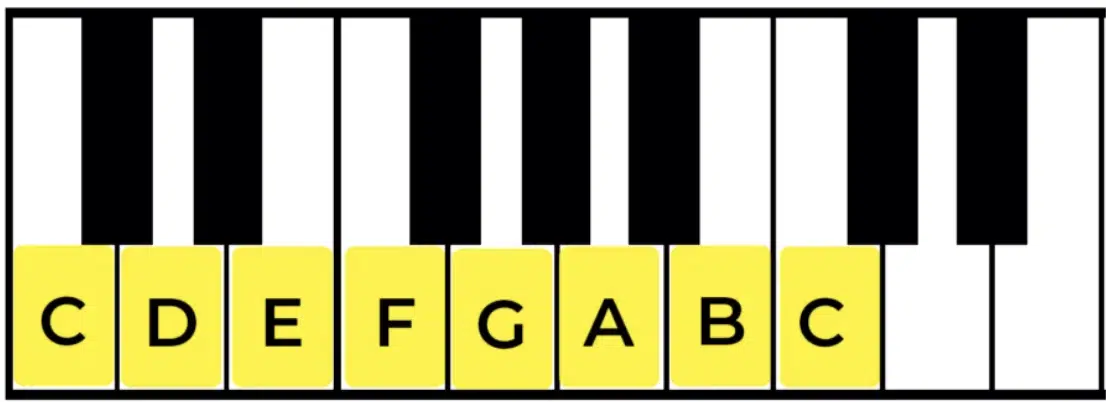
The Ionian mode is a fundamental concept in Western music theory and a cornerstone for many compositions you hear everyday.
As a digital music producer, understanding the Ionian mode can seriously enhance your skills and creativity level.
The Ionian mode (identical to the major scale) begins on any starting note and consists of seven notes arranged in a specific sequence of whole and half steps.
Starting on the root note, also known as the tonic note, the pattern progresses in the following sequence:
- Whole step
- Whole step
- Half step
- Whole step
- Whole step
- Whole step
- Half step
This structure forms the major scale, the most commonly used scale in Western music, and its this interval pattern that gives it the signature bright, uplifting sound.
Musicians and producers often start with the Ionian mode to create melodies and harmonies due to its simple, straightforward structure.
So, if you’re new to the game, this is a perfect place to start.
By mastering the Ionian mode, you can unlock the ability to create major chords and explore various chord progressions.
This knowledge will not only help you with composition, but also in understanding how different musical elements interact (which is super valuable).
-
The Structure Importance of the Ionian Mode

The structure of the Ionian mode, or major scale, is key for any music producer to understand, following the sequence of whole steps/half steps mentioned above.
For example, the C major scale (Ionian mode) consists of the notes C-D-E-F-G-A-B-C.
Each of these notes has a specific role and creates a unique relationship with the others 一 forming the major scale’s characteristic sound.
To put it simply, the Ionian mode is all about balance and harmony.
The combination of whole steps and half steps within one octave creates a scale that feels complete and resolved, which is why it’s described as:
- Happy
- Uplifting
- Stable
- Etc.
Understanding this specific structure allows you to build major chords and lay down melodies that resonate well with listeners.
As a producer, knowing how to construct and manipulate the Ionian mode can open up endless new creative opportunities in your tracks, so don’t overlook it.
-
Scale Degrees in the Ionian Mode

Each note in the Ionian mode, or major scale, is assigned a specific scale degree, which helps in identifying its role and function within the scale.
The scale degrees in the Ionian mode are:
- 1 (tonic)
- 2 (supertonic)
- 3 (mediant)
- 4 (subdominant)
- 5 (dominant)
- 6 (submediant)
- 7 (leading tone)
These scale degrees create a framework that you can use to build countless melodies and harmonies.
For example, in the C major scale, C is the tonic, D is the supertonic, E is the mediant, F is the subdominant, G is the dominant, A is the submediant, and B is the leading tone.
Understanding scale degrees helps in identifying which notes and chords to emphasize, and which ones don’t fit the overall vibe.
The tonic, subdominant, and dominant are particularly important as they form the basis of many chord progressions in Western music.
For example, the I-IV-V progression (C-F-G in the C major scale) is one of the most common chord progressions in music.
Knowing how to utilize these scale degrees effectively can make your music more dynamic and engaging.
Chords Derived from the Ionian Mode (Common Chord Progressions)
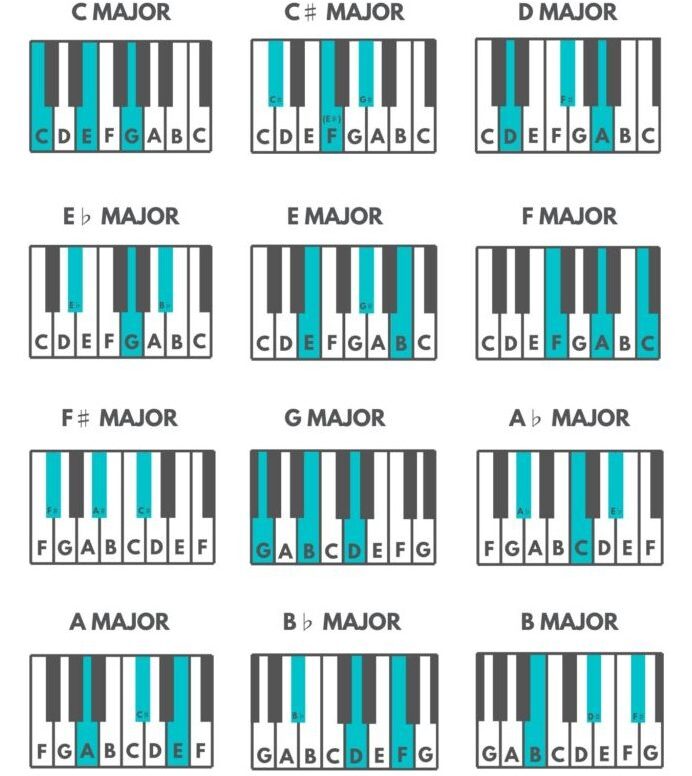
Chords derived from the Ionian mode form the backbone of countless musical compositions that you know and love.
The major scale, or Ionian mode, produces seven distinct chords, each built on a different scale degree, and these chords are:
- I (major)
- ii (minor)
- iii (minor)
- IV (major)
- V (major)
- vi (minor)
- vii° (diminished)
For example, in the C major scale, the chords are C major, D minor, E minor, F major, G major, A minor, and B diminished. .
Common chord progressions in the Ionian mode leverage these chords to evoke different emotions and dynamics that you feel fit your track.
The I-IV-V chord progression is one of the most popular and commonly used 一 creating a strong sense of resolution and stability.
Another popular progression is I-vi-IV-V, which adds a touch of sadness with the minor vi chord before resolving back to the major V chord.
By experimenting with these and other progressions, you can create songs that move and captivate your audience, utilizing the full potential of the major scale.
Using the Ionian Mode Creatively
The Ionian mode offers endless creative possibilities, so let’s explore some techniques that will help you really take advantage of its power in your tracks.
-
Writing Melodies in the Ionian Mode
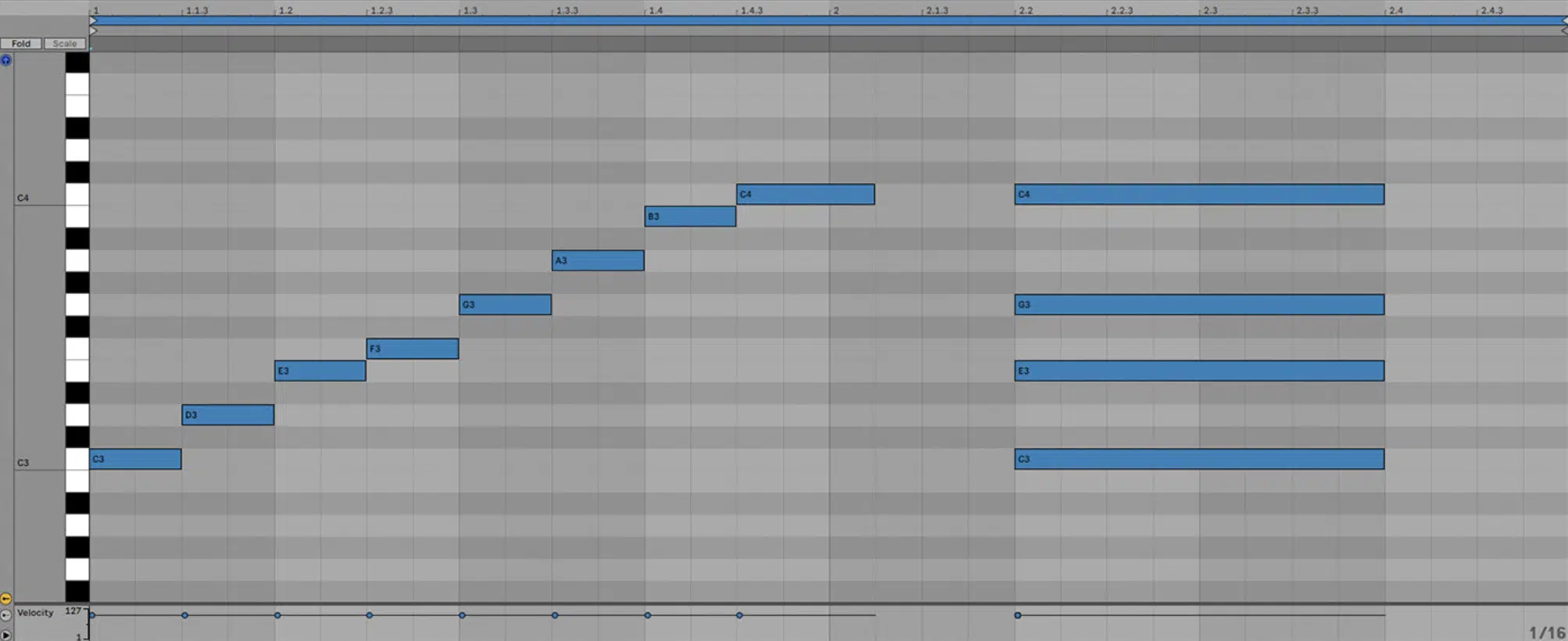
Writing melodies in the Ionian mode involves creating sequences that follow the major scale’s specific interval pattern.
Start by selecting a root note, then use the Ionian mode formula of whole steps and half steps to build your melody.
For example, a melody in the C major scale might start with the four notes C-D-E-F.
By focusing on the strong scale degrees like the tonic (C), dominant (G), and mediant (E), you can create memorable and impactful melodies.
Incorporating rhythmic variation and dynamics can enhance your melodies even more.
- Use longer notes on the tonic & dominant to build a strong foundation.
- Use shorter notes to add interest and movement.
Make sure to experiment with different starting notes and motifs to discover unique melodic ideas 一 it’s all about getting creative.
Whether your genre is pop, rock, or EDM, the Ionian mode provides a versatile starting point for creating catchy and engaging melodies.
-
Harmonizing Melodies in the Ionian Mode

Harmonizing melodies in the Ionian mode involves adding complementary notes to your main melody to create mesmerizing, full-sounding harmonies.
One common technique is to harmonize in thirds, where each note of the melody is paired with a note a third above or below.
For example, if your melody in the C major scale is C-D-E-F, you can harmonize it with E-F-G-A to create a pleasing, consonant sound.
It will enhance the overall musical texture.
Another approach is to use sixths or even full chords to harmonize your melodies.
Harmonizing in sixths involves pairing each melody note with a note a sixth above or below, which can add a warm, lush quality to your music.
Pro Tip
Full chord harmonization involves using the appropriate chord from the major scale to support each melody note, creating a more complex and harmonically-packed sound. By experimenting with these techniques, you can add depth and flair to your tracks, making your music more engaging and dynamic as a whole.
-
Utilizing the Ionian Mode in Synths and Samples
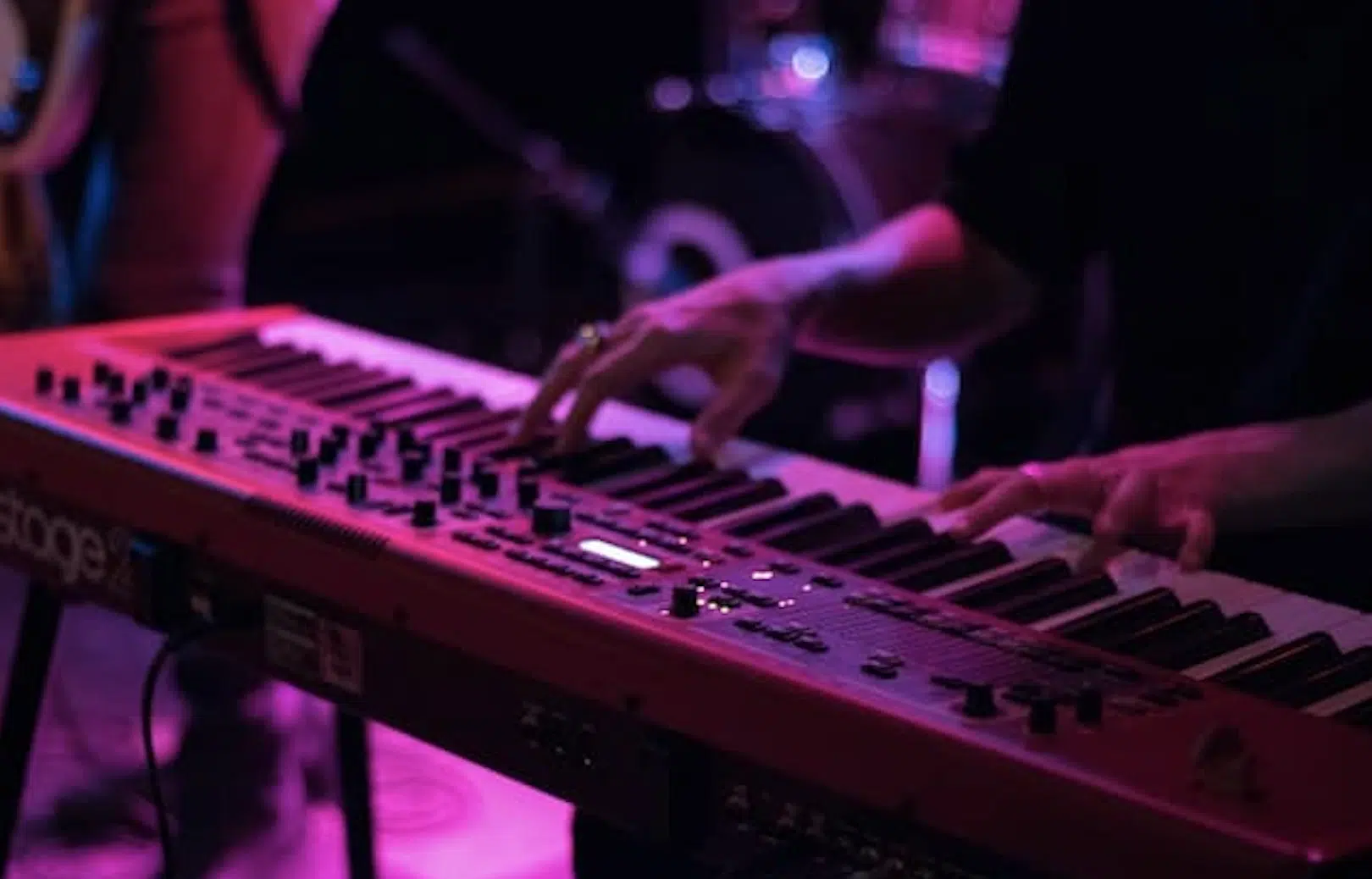
Utilizing the Ionian mode in synths and samples can add a distinctive edge to your tracks and make them a little more desirable.
Start by programming your synths to follow the major scale’s intervals/interval patterns.
For instance, in the C major scale, use the seven notes C-D-E-F-G-A-B to create your synth lines and ensure your synth melodies/harmonies fit within the Ionian mode framework.
It will give your tracks a more fluid feel.
When working with samples, choose those that align with the Ionian mode to maintain musical consistency.
For example, use C major chord samples or loops in your projects to ensure they blend perfectly with other elements in your track.
Experiment with layering different samples and synths to create more textured sounds that enhance the overall musical experience.
By utilizing the Ionian mode in your synths and samples, you can create tracks that are both sonically interesting and melodically engaging.
-
Layering Sounds in the Ionian Mode
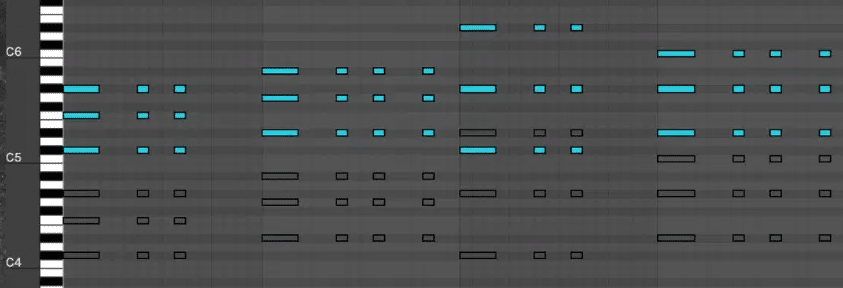
Layering sounds in the Ionian mode can add even more depth and complexity to your music so it will have some added edge.
You’ll want to start by stacking different sounds that follow the major scale’s structure 一 like layering a C major chord with a melody line in the C major scale.
It will create a more full, lush, immersive sound that people really respond to.
Experiment with different textures and timbres when layering sounds, and try to combine:
- Synths
- Samples
- Live instruments
For example, pair a bright synth lead with a warm pad in the Ionian mode to create contrast and interest (remember, it’s all about tension and release).
By carefully balancing the frequencies and dynamics of each layer, you can ensure they complement each other and contribute to an overall solid piece of music.
Advanced Ionian Mode Concepts
Once you’re comfortable with the basics of the Ionian mode, you can explore more advanced concepts to take your skills to the next level. So, let’s dive into modulation, key changes, and combining the Ionian mode with other modes.
-
Modulation and Key Changes
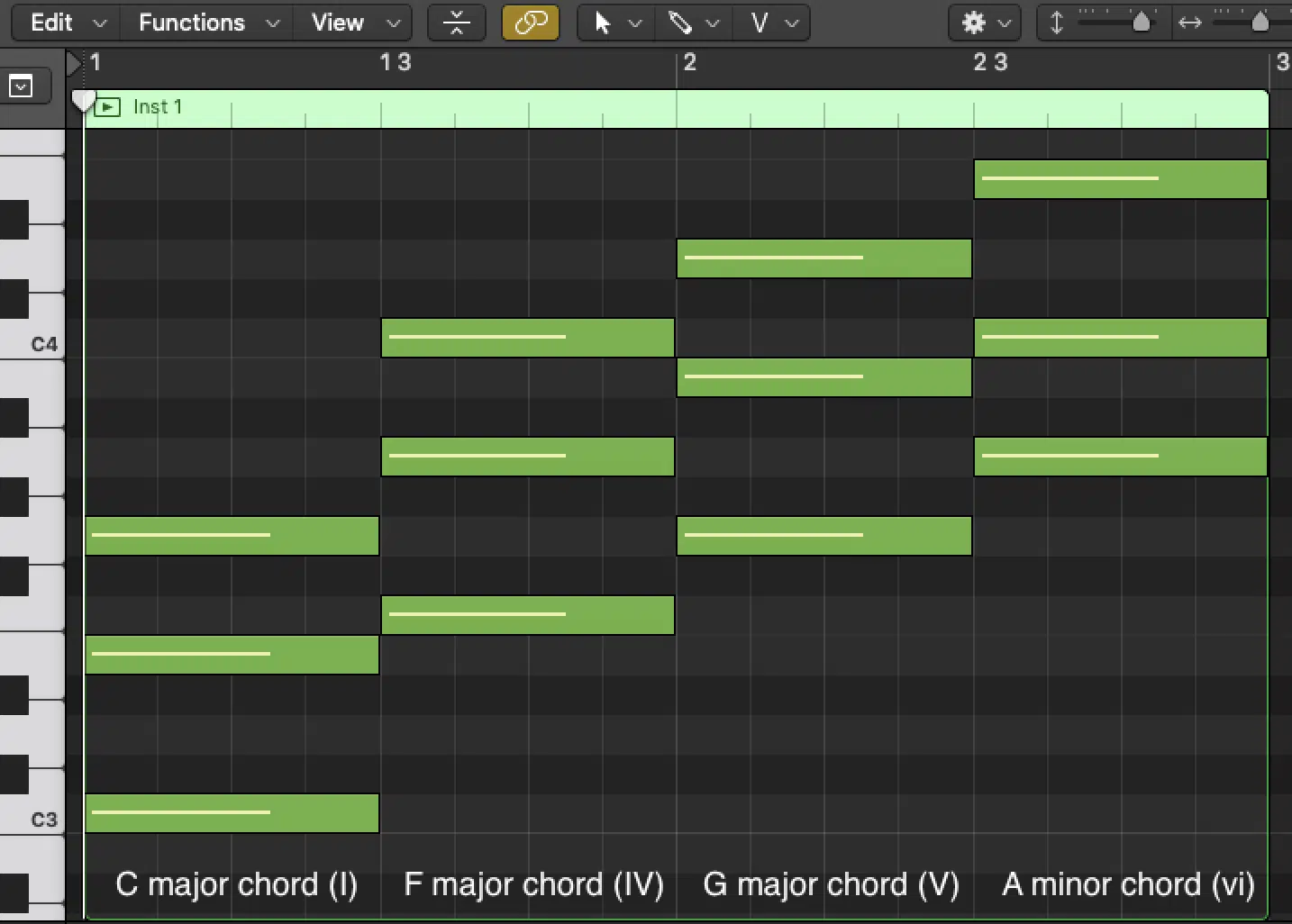
Modulation and key changes in the Ionian mode can add excitement and variety to your music 一 it involves changing from one key to another.
There are countless examples, but let’s go with the C major scale and modulate to G major, which is a common and smooth transition.
This shift can introduce new tonal colors and keep your listeners engaged.
To execute a key change, use pivot chords that are common to both keys… For instance, the G major chord (V in C major) can also be the I chord in G major.
This will make the transition super smooth, which is always what you want.
If you’re looking to highlight different emotional peaks in your track, modulating between keys can certainly help.
Playing around with modulation in the Ionian mode can expand your creative toolkit and lead to more interesting musical narratives.
-
Combining the Ionian Mode with Other Musical Modes
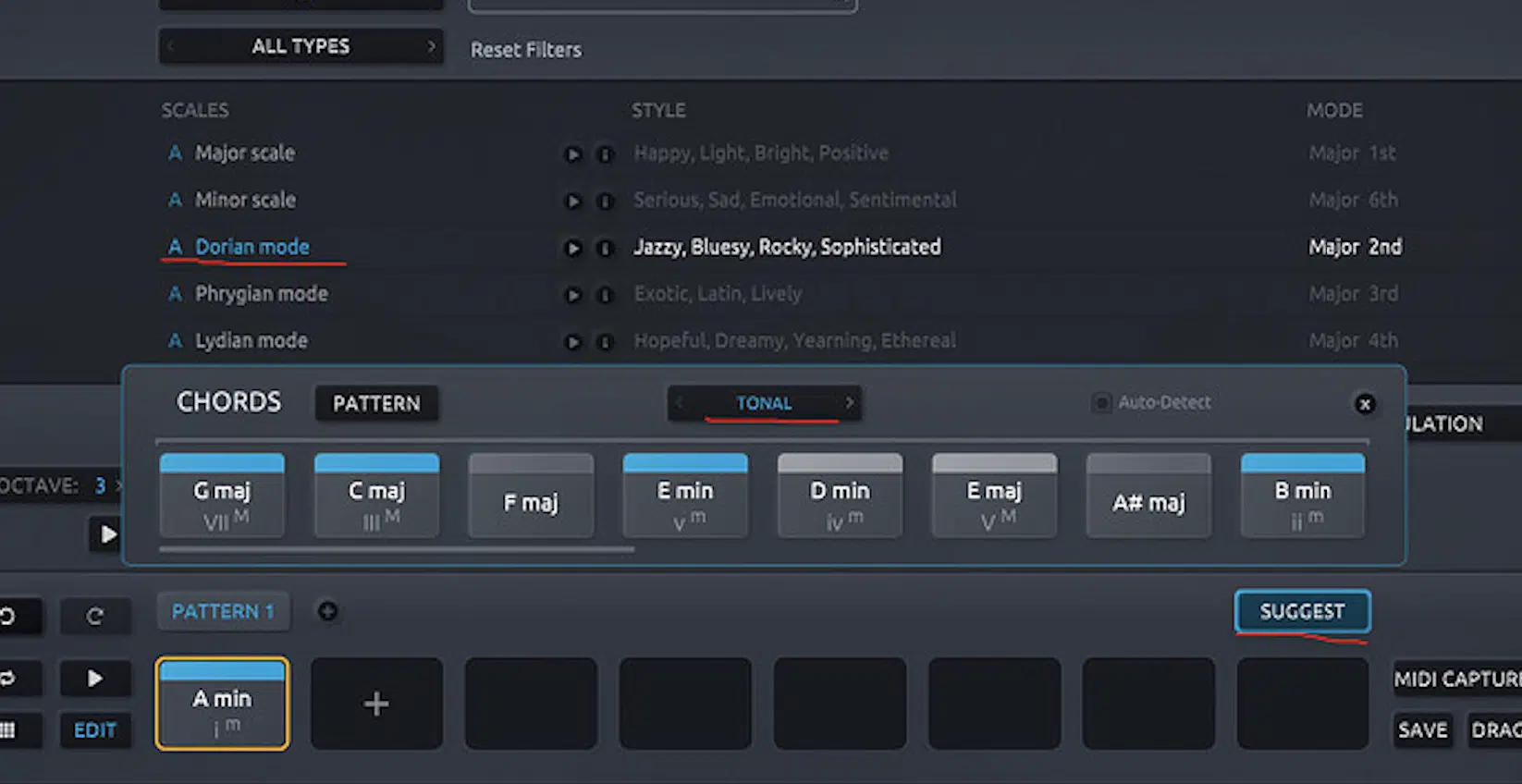
Combining the Ionian mode with other musical modes can add extra complexity.
For example, you can transition from the Ionian mode to the Dorian mode by altering the scale pattern.
In the C major Ionian mode, this means moving from C-D-E-F-G-A-B to D-E-F-G-A-B-C, which introduces a minor third (F to D) and a different feel.
It creates contrast and interest in your track.
You can also use modal interchange to borrow chords built from other modes while staying in the Ionian key.
For example, incorporating the iv chord from the Aeolian mode (natural minor scale) into a C major progression can add a more nuanced emotion.
This technique allows you to mix the bright, stable sound of the Ionian mode with the darker, more complex tones of the minor modes.
By blending the Ionian mode with other musical modes, you can create unique harmonic sounds and expand your expression.
Production Tips
You should have a pretty solid understanding of the Ionian mode now, so let’s break down some expert production tips. This way you can incorporate the Ionian mode into your basslines, drum patterns, and more.
-
Ionian Mode in Basslines
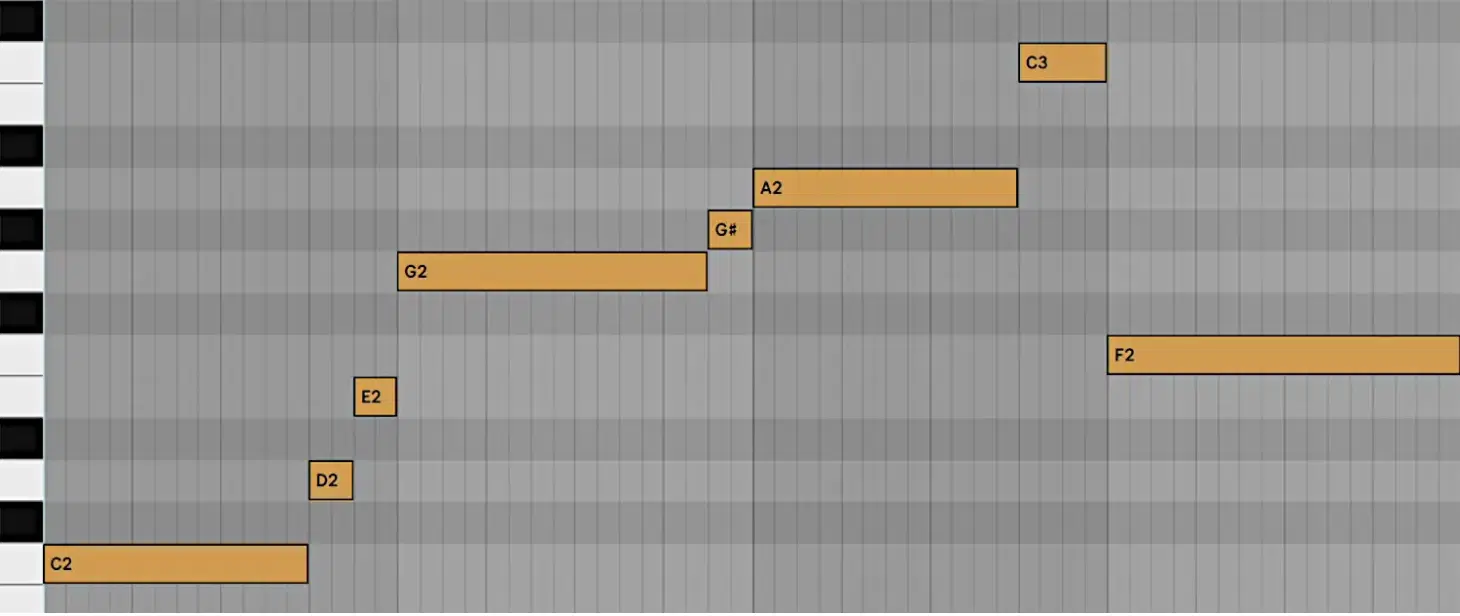
Incorporating the Ionian mode into your basslines can provide a solid foundation for your tracks, so start by identifying the root note of the major scale you’re using.
For example, if you’re in the C major scale, it would of course be C.
Build your bassline around this root note 一 ensuring it follows the Ionian mode’s interval pattern.
For instance, a bassline in the C major scale (C Ionian mode) might use the three notes C-E-G to create a strong, stable foundation.
Experiment with different rhythms and note lengths to add variety and interest to your basslines (different syncopation and groove techniques are key here).
Pro Tip
Try playing a syncopated rhythm using the notes C-D-E-F-G in the C major scale to create a driving, energetic feel. By leveraging the Ionian mode in your basslines, you can create compelling tracks people get instantly hooked to.
-
Drum Patterns and Rhythms

While the Ionian mode primarily concerns melody and harmony, it can also influence your drum patterns and rhythms.
Consider the overall feel and mood of the major scale when designing your drum parts, like a bright drum pattern can complement the uplifting nature of the Ionian mode.
Make sure to use rhythmic variations to enhance the major scale’s character.
Incorporate elements like:
- Syncopation
- Accent patterns
- Dynamic changes
This will, again, add depth to your drum tracks.
For example, accenting the downbeats while adding syncopated snare hits can create a lively and engaging rhythm.
Pro Tip
Experiment with different drum sounds and patterns to find the perfect match for your major scale-based compositions. By aligning your drum patterns with the Ionian mode, you can create tracks that are both rhythmically and harmonically on point.
-
Using the Ionian Mode in Film Scoring
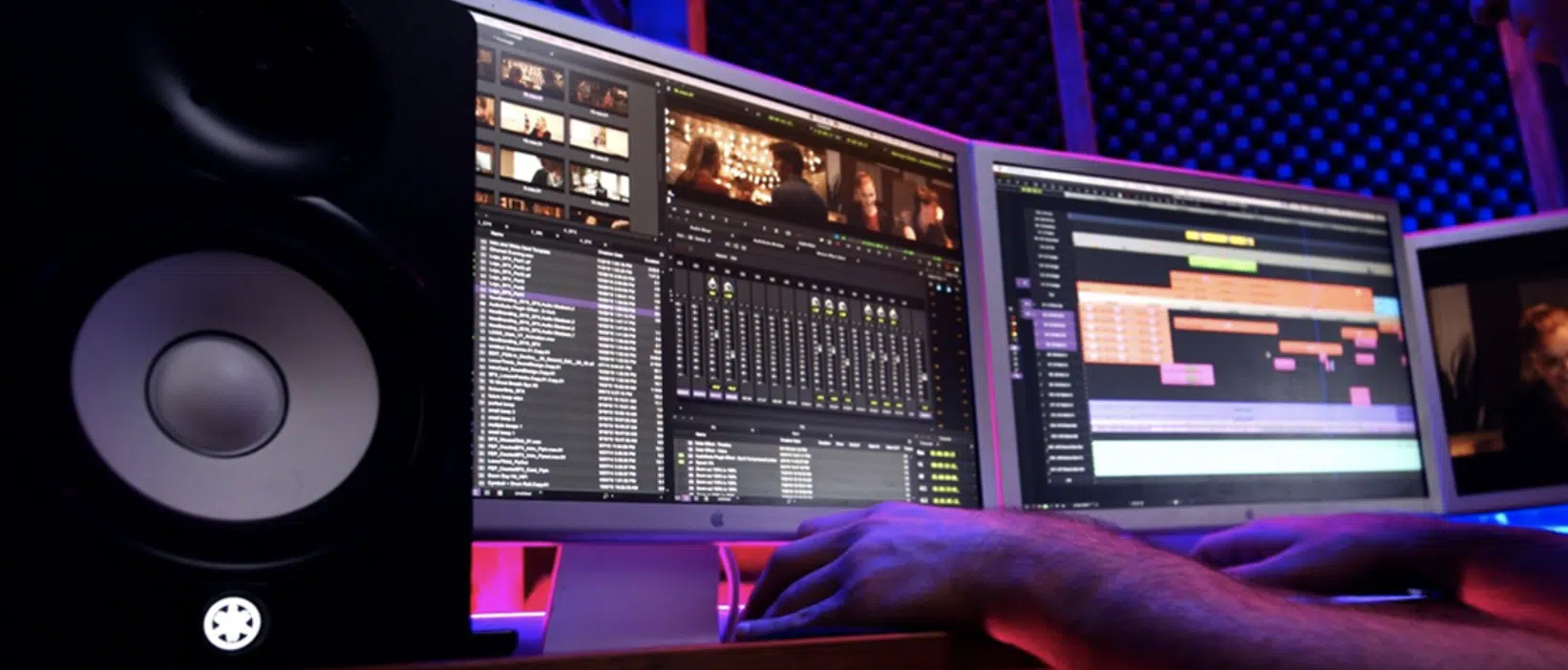
Using the Ionian mode in film scoring can help set a positive and uplifting tone for your scenes, making it perfect for:
- Resolution
- Happiness
- Triumph
For example, a hero’s triumphant return might be underscored with a melody in the C major scale, which emphasizes the bright and victorious nature of the moment.
On the flip side, the Ionian mode can be used to contrast darker, more intense scenes scored in minor modes 一 providing a sense of relief and balance.
By understanding the emotional qualities of the Ionian mode, you can enhance the narrative of your film projects.
Use the Ionian mode creatively to highlight key moments and support the overall storytelling process (like guitar solos).
Exploring the Seven Musical Modes
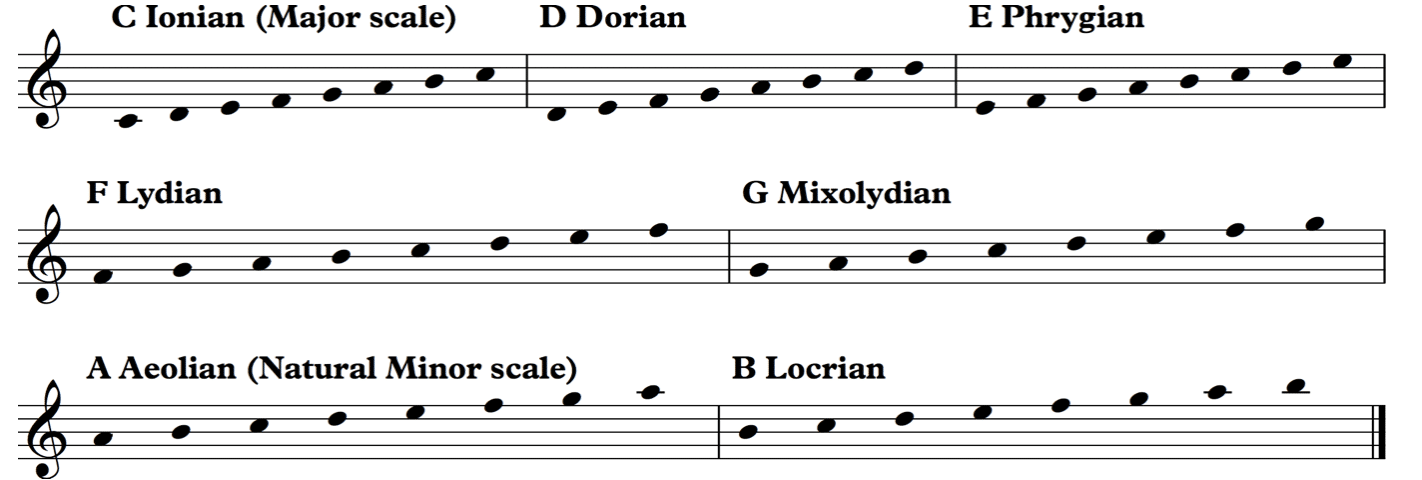
The Ionian mode is just one of the seven musical modes, each with its own unique character and feel.
These seven modes are derived from the diatonic scale (diatonic modes) and include the:
- Ionian mode
- Dorian mode
- Phrygian mode
- Lydian mode
- Mixolydian mode
- Aeolian mode
- Locrian mode
Understanding these diatonic modes can seriously enhance your compositional skills.
For example, the Ionian mode, or major scale, provides a bright and stable sound perfect for uplifting and happy music (which we’ve covered).
The Dorian mode, with its natural sixth, offers a slightly jazzy and soulful feel, which is why it’s absolutely great for genres like jazz and blues.
Exploring these seven modes will help you create more nuanced emotions and different harmonic variations in your music.
Each mode starts on a different starting note of the major scale/ionian scale and follows a unique pattern of whole steps and half steps.
For instance, the Dorian mode starts on the second scale degree of the major scale and follows the pattern 一 whole step, half step, whole step, whole step, whole step, half step, whole step.
In the context of the C major scale, Dorian would start on D (D-E-F-G-A-B-C-D), and Phrygian would start on E (E-F-G-A-B-C-D-E).
The Mixolydian mode, starting on the fifth scale degree, introduces a flat major seventh, giving it a more bluesy, rock-oriented feel.
The Aeolian mode (natural minor scale) starts on the sixth degree and is commonly used in many genres to give off a more melancholic vibe.
Each of these seven modes provides a distinct flavor and can be used creatively to add depth to your compositions.
Minor Modes and Their Characteristics
While the Ionian mode is synonymous with the major scales, several modes have a minor quality that can add depth and complexity to your compositions. It’s important for you to know both in order to really master theory.
-
Aeolian Mode
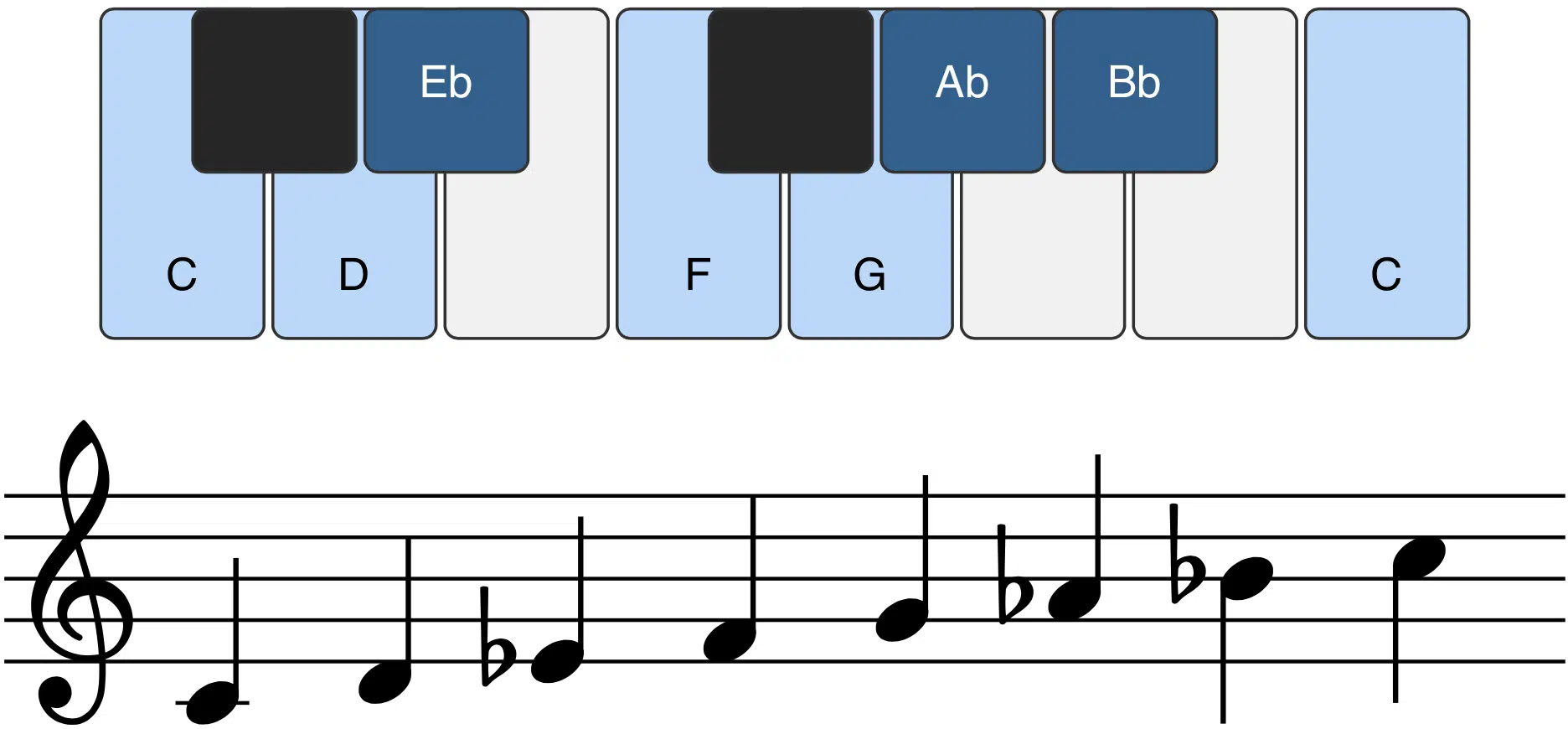
The Aeolian mode, also known as the natural minor scale, is one such example.
Starting on the sixth scale degree of the major scale, the Aeolian mode creates a darker, more introspective sound.
For instance, in the C major scale, the A minor scale (A-B-C-D-E-F-G-A) is the Aeolian mode.
This minor mode is often used in genres like R&B and contemporary pop to evoke emotions of sadness or contemplation.
The characteristic sound of the Aeolian mode comes from its unique pattern of whole steps and half steps: whole step, half step, whole step, whole step, half step, whole step, whole step.
-
Other Minor Modes
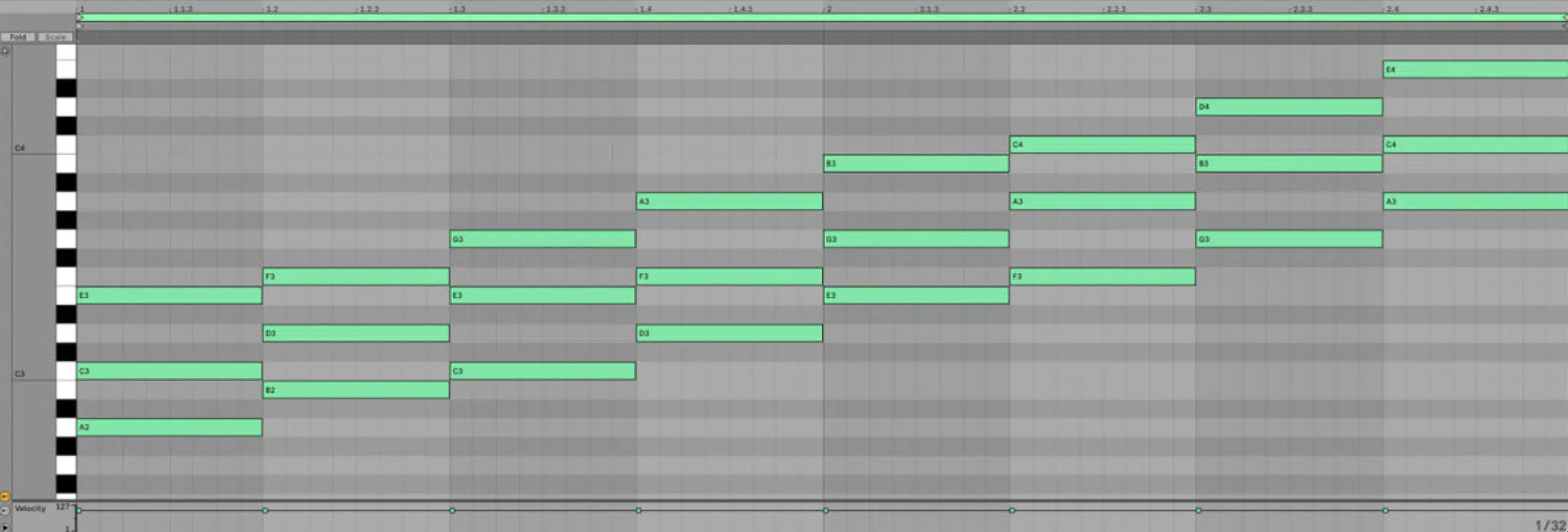
Other minor modes in western music theory include Dorian and Phrygian, each bringing a unique twist to the minor sound.
The Dorian mode, starting on the second scale degree, features a natural sixth, giving it a slightly brighter feel than the Aeolian mode.
In the context of C major, D Dorian (D-E-F-G-A-B-C-D) is a great example.
This music mode is often found in jazz and folk music due to its distinctive sound that blends the qualities of the minor and major scale starting.
The Phrygian mode, starting on the third scale degree, introduces a flat second 一 creating a distinctly exotic or Spanish flavor.
In the C major scale, E Phrygian (E-F-G-A-B-C-D-E) can add a dramatic, intense character to your music.
These minor modes expand your harmonic vocabulary and allow you to convey more nuanced emotions in your tracks all day.
The Ultimate Ionian Scales MIDI Collection
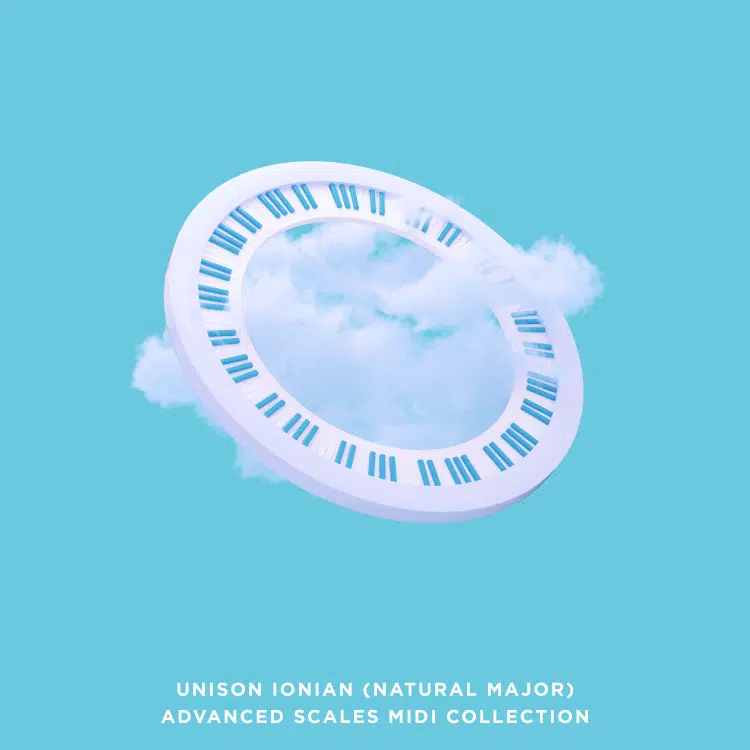
The Unison Ionian (Natural Major) Advanced Scales MIDI Collection is an essential tool for any music producer looking to enhance their tracks with high-quality Ionian mode sequences.
This collection includes over 1,100 MIDI files covering scales, chords, progressions, and melodies specifically designed for the Ionian mode.
These MIDI files can be used across various DAWs and instruments 一 allowing you to drag and drop them directly into your projects for instant inspiration.
This collection eliminates the need for extensive music theory knowledge, which is invaluable, and it’s insanely versatile as well.
It includes MIDI files for leads, plucks, pads, keys, and arpeggios so that every element of your track can be enriched with the Ionian mode.
This pack is super useful for creating catchy, advanced, and attention-grabbing music, making your productions stand out.
Whether you are working on pop, rock, EDM, or any other genre, this collection provides a solid foundation and endless creative possibilities.
It will help you produce tracks that captivate your listeners and learn all about the Ionian scale with no music theory needed!
Ionian Mode: Final Thoughts
There you have it; you now have everything you need to master the Ionian mode.
You’ve learned about its structure, scale degrees, and learned how to lay down epic melodies and harmonies.
Plus, with insights into advanced concepts like modulation and combining modes, you’re equipped to create tracks with depth and variety.
Plus, with the Unison Ionian Scales MIDI Collection, you can streamline your workflow and produce professional-quality music effortlessly.
Armed with this knowledge, you’re ready to elevate your music production skills and create tracks that truly resonate with your audience.
But remember, never stop learning, growing and evolving as a producer 一 it’s the key to a long-lasting career.
Until next time…







Leave a Reply
You must belogged in to post a comment.